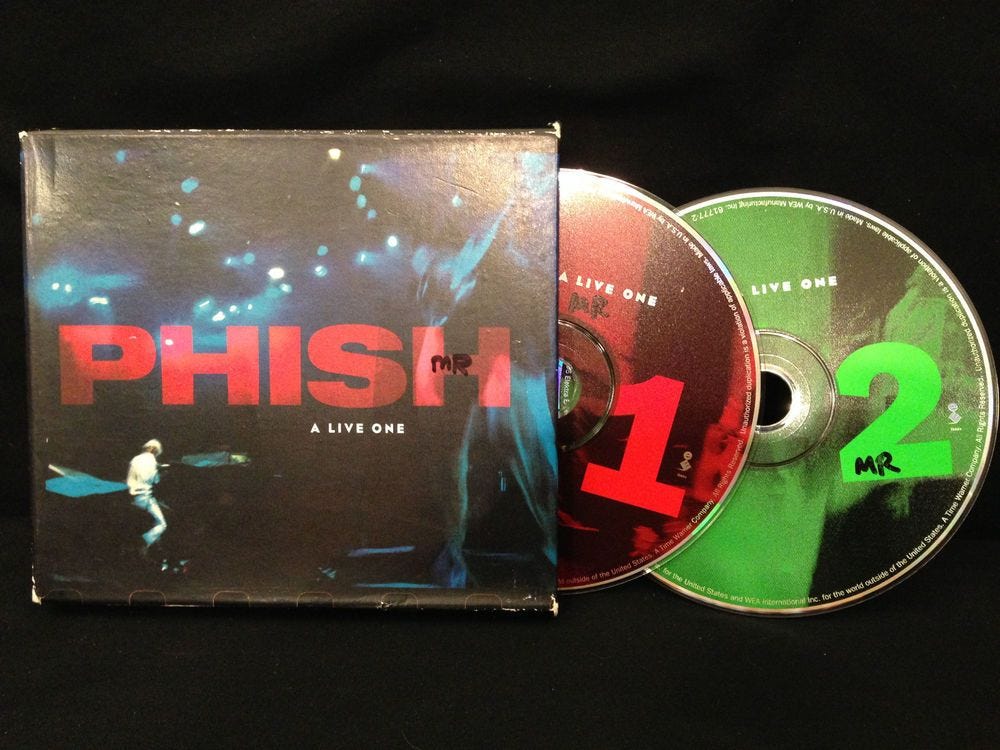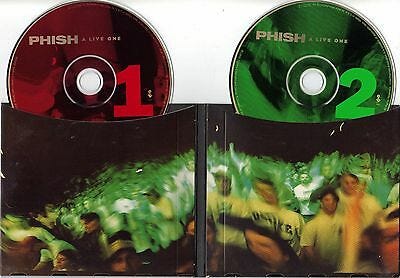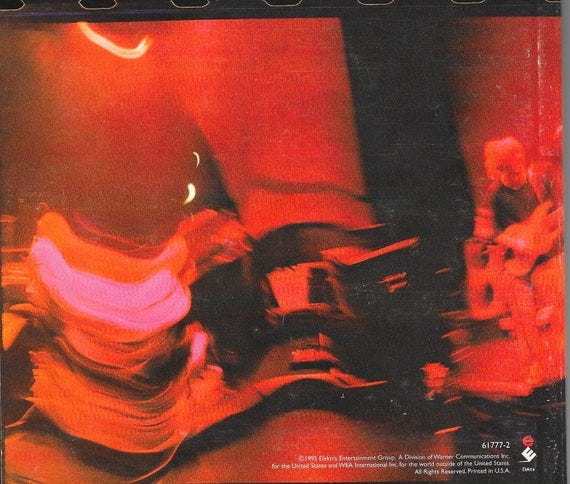Another Live One

When Phish finished their Fall 1994 tour, they did something unusual: they listened to the tapes. After hauling a multi-track recording studio around with them for two months, it was time to sort through 50 Fall and NYE shows — plus any summer highlights they wanted to tap — and curate what would become A Live One, their first official live release. According to Parke Puterbaugh’s biography, the initial list included over 500 tracks, boiled down to 30 after two months of voting by the band, its inner circle, and even a fan poll. When they were finally finished, they had two discs, twelve tracks, and 131 minutes of music that they felt captured the best of Phish on stage in 1994.
A Live One did a great job, but that intensive editing process naturally left a lot of great material on the cutting room floor. It’s not just missing specific performances that could’ve replaced the chosen tracks, but also some more general characteristics of Phish as they existed in the early-to-mid 90s. No two-disc set could have captured every angle, and there are some aspects of the Phish experience that they, understandably, would leave off a release meant to enlarge their audience, not preach to the choir. But it still remained an incomplete picture.
Happily, today we have one-click access to all the same music — albeit not all in the same multi-track SBD quality — as Phish did during their selection process. So upon completion of the Fall 94 essays, I decided to go back and build my own supplement to A Live One, containing some of the songs and sounds that Phish didn’t have room for. I mostly tried to follow the same format: two discs, roughly 75 minutes each. I ruled out including different versions of songs that appear on the official release; my apologies to the Mahaffey Hood. Phish pulled one track (Stash) from Summer 1994 and two (Bouncin’ and Wilson) from the NYE run, I restricted myself to the fall tour proper. Apart from that, it’s the same idea: approximate the structure of a typical Phish show and try to represent different aspects of their sound, circa late 1994.
You can listen to Another Live One as a playlist on phish.in, with one slight, manual adjustment that I’ll explain momentarily.

Disc 1
Track 1: Runaway Jim (10/29)
The first two tracks are me taking the “approximate the structure of a typical Phish show” rule very literally. The Jim > Foam combination opened up 13 shows in 1994 — the only chalkier Phish bet was calling 2001 to open the 2nd set. The 10/29 Jim actually came in the middle of the first set, but that meant they were a little more warmed-up, and it pays off in a unique jam, foreshadowed by Fishman using a disco four-on-the-floor beat in the breakdown. Like a lot of 1994 versions, the jam flirts with Santana’s “Gypsy Queen” and packs an enormous amount of rhythmic complexity under 10 minutes.
Track 2: Foam (11/16)
There are several excellent Foams from the tour I could choose from, and they’re not dramatically different from one another. But I wanted to pick a version that captured one of the band’s favorite tricks of 1994: the nearly-silent jam. There’s the Divided Sky pause that Trey grew so fond of at this time, but that’s more an experiment in tension — if you know the song, you know the next note that’s coming, it’s just a matter of when. The quiet part of Foam gets closer to what Trey told Steve Silberman:
It’s a really intense moment, because people are hearing it get quieter and quieter, and they’re following the way the music is going, and there’s a line somewhere – for each person, it’s probably a little bit different – where it gets quieter than the threshold of their ability to hear it. But I’m sure people are still hearing it, even after it crosses the threshold. For me it’s like, “Are they still hearing what I’m playing in my mind, or are they making it up?” Because if they are making it up, then that’s the greatest thing of all, because you’ve got a really creative audience going.
This segment got longer and quieter as the tour went on — the 12/4 version reaches total silence — but I picked an intermediate version from the Hill Auditorium, where the perfect acoustics capture the delicacy of the moment, even in AUD. Admittedly, this experience might not have translated well on an official release, but I do think Phish would appreciate the gag of making unsuspecting listeners crank up their volume, only to get ambushed when the song returns to normal volume.
Track 3: Maze (11/2)
The one major piece of the Phish puzzle missing from A Live One is Noise Phish — the more abstract, effects-heavy style that Trey started to selectively deploy in 1994. The quickest remedy for this oversight is to include a Maze, the song where you most often found Trey whipping up siren-like drones instead of soloing traditionally. The Bangor Maze is the runaway vehicle that scrapes the guard rails of the song the most in Fall 1994; you can hear it go deliciously weightless for a few seconds at 8:40 and again at 9:50. And don’t sleep on Page’s raucous organ solo (and Trey’s expert comping) either.
Track 4: Columbia (11/22 Funky Bitch Jam)
The most mysterious track on A Live One was Montana, an atmospheric snippet of the Bozeman Tweezer that worked as a bridge between the easy funk of Gumbo and the proggy tangles of You Enjoy Myself. As its counterpart here, I bring you “Columbia,” an excerpt from the lengthy jam out of Funky Bitch on the Mizzou campus. Including only part of the jam solves two problems: obeying the original album’s no-covers rule (though I’ll break that later) and keeping the total runtime of this “disc” under the technical limit of 80 minutes.
The playlist editor won’t let me slice out my chosen excerpt, so you’ll have to jump to it yourself (or just let the whole jam play out, it’s worth it). Start the segment at 7:20, where the band reconstructs the jam from a space of ambient quiet, Trey hitting upon a somber riff and slowly iterating upon it until the band finds a menacing glide. Fade it out when things get quiet again at 15:00, and hop to the next track...
Track 5: Reba (10/31)
Reba feels like one of the most essential Phish songs left off A Live One, though it’s hard to say whose place it should have taken; maybe you sub it in for Slave, but then you lose that track’s “set” closing perfection. Instead, we’ll give it a slot here and use its sublime Halloween performance, often overshadowed by the White Album set. The composed section is played mostly clean, and the fluttering, collective jam provides representation for the beautiful side of Phish jamming amid the darker cuts I’ve chosen.
Track 6: Run Like An Antelope (12/9)
Apart from Chalkdust, A Live One only hints at the full rock intensity that Phish shows could reach, setting up new fans for a shock when they hit their first show in the adrenaline-soaked year of 1995. Including any Fall 1994 Antelope would spoil the surprise and dissuade people from thinking they were just a nice, gentle hippie band, and none more so than this rabid 15-minute version, which accelerates repeatedly until Fishman starts emitting black smoke. Sure, they’d have to pay a few royalties to John Williams, but coming out four years before The Phantom Menace, Phish would’ve been ahead of the Star Wars revival curve.

Disc 2
Track 1: Llama (11/18)
Another slice of Noise Phish, and a fiery opener to keep the pace high after you switch discs. Trey’s approach to Llama in this era was much the same as Maze, but condensed and layered over a blistering tempo. This version stands a head taller than the rest this fall, taking a dark turn via a dissonant Mike bassline and Trey’s subsequent decision to just wring a single chord to death for a solid minute while all hell breaks loose around him. It doesn’t so much end as expire.
Track 2: Down with Disease > Have Mercy > Down with Disease (11/12)
It makes sense that Phish ignored Hoist on A Live One, given that it was only a year old and its songs hadn’t yet progressed very far from their studio versions. But by the end of fall, Disease started hinting at its promising future, particularly in this version, where the song’s triumphant riff spins off into a freewheeling improvisation that travels all the way to dub reggae and back. There’s really no better example from this tour of the band learning how to traverse not just chord progressions and keys but entire genres within a single jam.
Including Have Mercy breaks the all-originals format, but I think it’s an allowable exception. In assembling A Live One, Phish likely wanted to both showcase their own material and avoid being dismissed as a cover act. But The Mighty Diamonds are hardly a household name, and Have Mercy gives Phish a chance to show their irie side in a more respectful manner than, say, Makisupa Policeman.
Track 3: If I Could (11/20, with Rev. Jeff Mosier on banjo)
The A Live One Gumbo represents the handful of horn section shows the band played in 1994. But the band’s other long-term guest that year, the Reverend Jeff Mosier, didn’t get a spot, possibly as a result of the no-covers rule, but maybe also because they were bashful about their bluegrass dabblings. Problem solved by this Hoist ballad, which not only provides a breather between this disc’s two big slabs of improvisation but also a subtle taste of Mosier’s banjo and the band’s softer side. If I Could fell out of regular rotation too quickly, as it’s one of Trey’s best ballads, and the song’s furious end solo and big earnest christian-rock “WOAH-OHHHH” conclusion deserve to be enshrined on a live release.
Track 4: David Bowie (11/26)
Bowie and Tweezer were the dueling laboratories of fall, with each subsequent version in November trying to break new runtime records. And yet Bowie didn’t make the ALO cut, likely because including one half-hour jam was already risky enough. So let’s right that wrong and include a Bowie...but not the 12/29 version, since we’re sticking to Fall proper.
If you’ve been following these essays, you already know how much I love this Bowie from Minneapolis. At 37 minutes, it’s an even longer commitment than the Bangor Tweezer, but it’s far more focused and thus feels like less of a full meal. That’s because it’s easily partitioned into three courses: a long stretch of tremendous, standard Bowie jamming, a noisy segment featuring a rare non-humorous use of vacuum, and an electric final section teasing the competitive Trey/Fish interplay that would come to define 1995. A Live One, to its credit, didn’t flinch at capturing the new longform, experimental improvisation Phish was just starting to explore at the time, and this is another worthy representative of that progress.
Track 5: Amazing Grace (12/7)
Love it or hate it, you can’t properly portray early 90s Phish without an acapella song. Rather than leave listeners with the belly-busting Bowie, here’s a little dessert in the form of everyone’s favorite spiritual written by a slave trader. Finding a version that isn’t interrupted by attention-seeking audience members is a chore, but this one from the tiny Spreckels Theatre in San Diego is fairly well-behaved.
